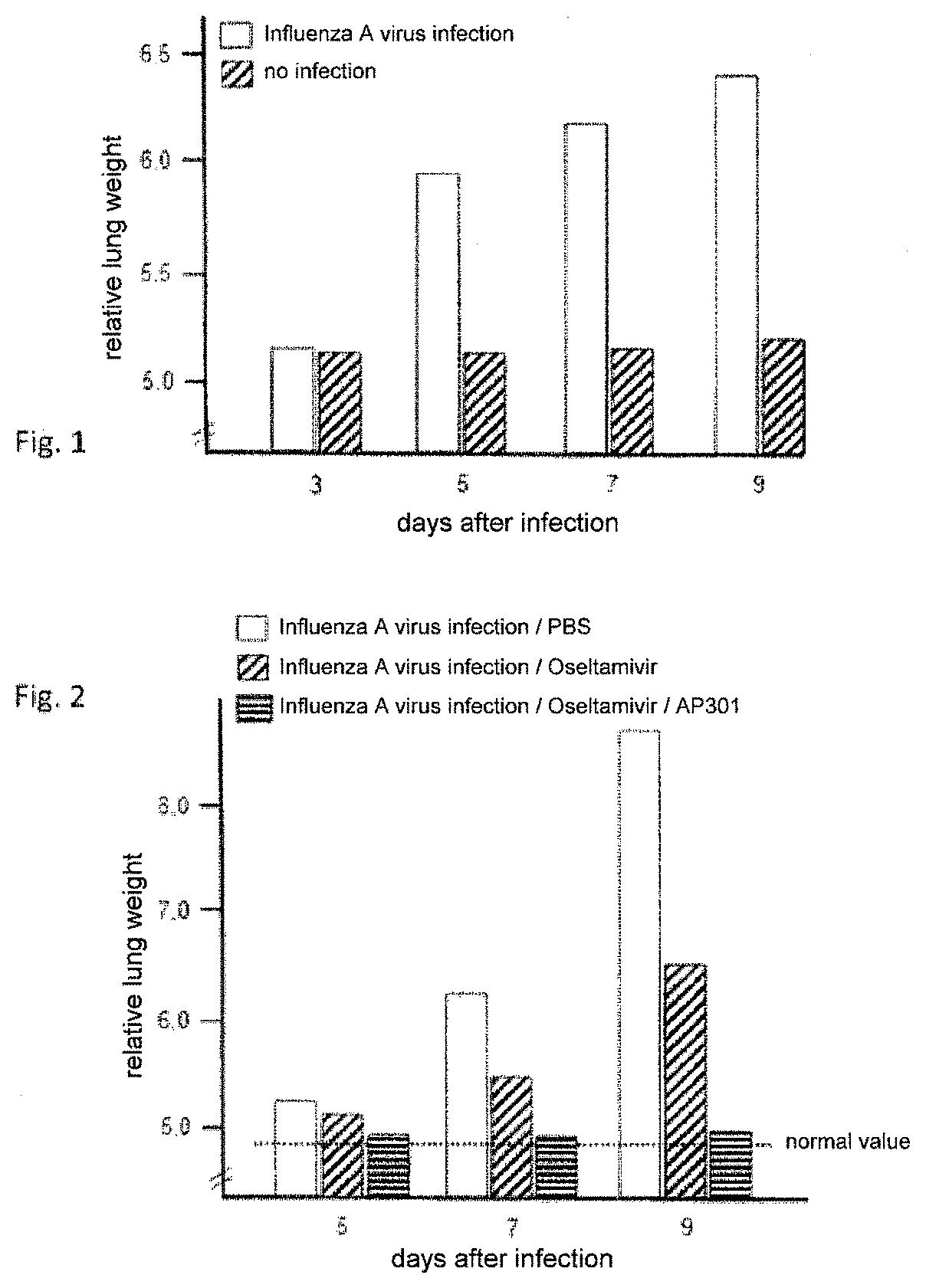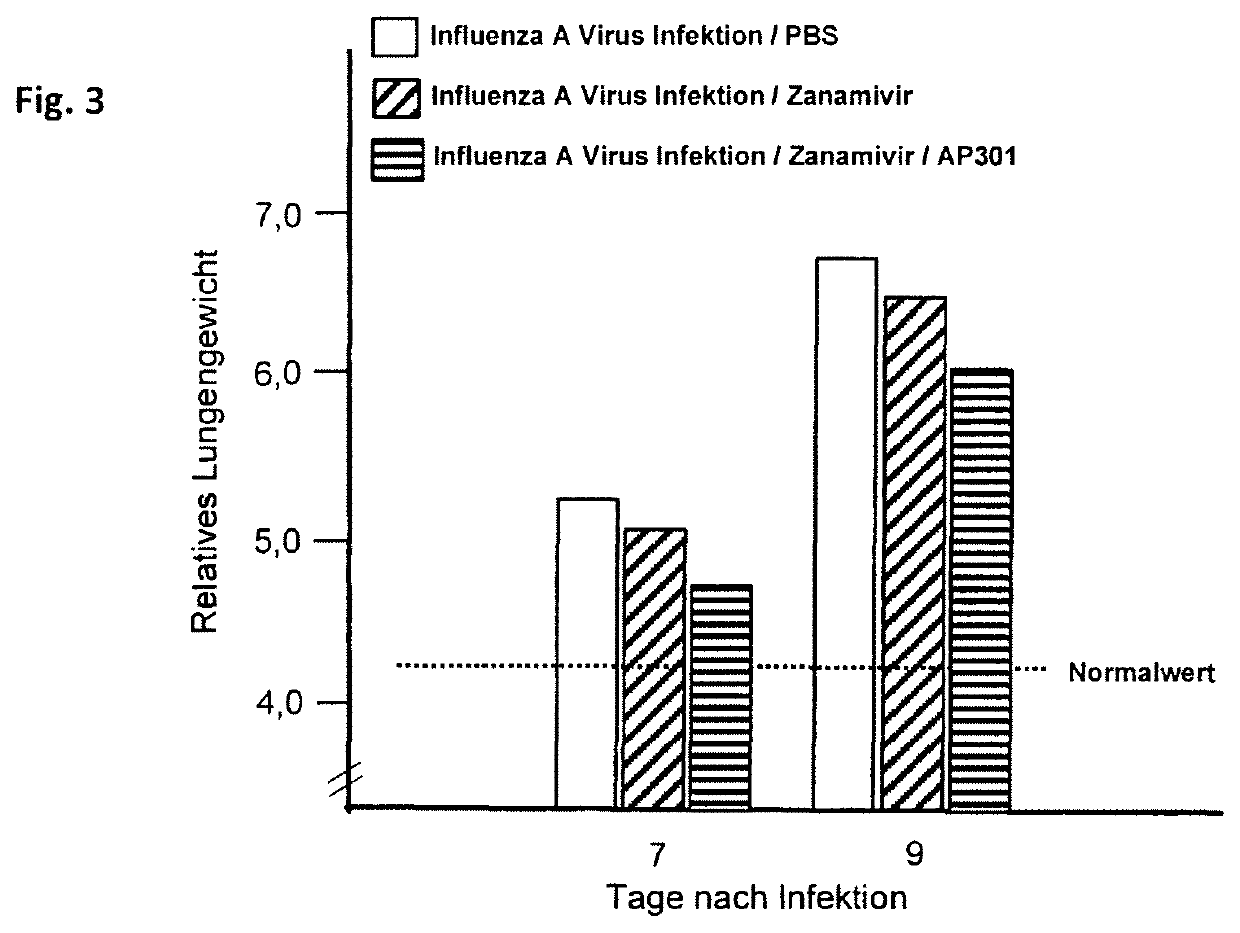Composition Comprising a Peptide and an Inhibitor of Viral Neuraminidase
a technology of viral neuraminidase and peptide, which is applied in the direction of ngf/tnf-superfamily, enzymes, animal/human proteins, etc., can solve the problems of inability to inactivate viruses, severe, life-threatening influenza, etc., and achieve the effect of improving the therapeutic effect of such inhibitors and improving pharmaceutical compositions
- Summary
- Abstract
- Description
- Claims
- Application Information
AI Technical Summary
Benefits of technology
Problems solved by technology
Method used
Image
Examples
example 1
[0061]Infection with influenza virus causes the development of a pulmonary inflammation. Laboratory mice (strain C57BL / 6, 8 weeks old) were infected per-nasal with the influenza strain A (PR8 / 34) at a dose of 150 PFU. On days 3, 5, 7 and 9 following the infection, the lungs were taken out of 8 mice, respectively, and the relative lung weight was determined as a measure of the pulmonary inflammation.
[0062]The examination showed that with increasing length of time following the mice's infection with the influenza virus the lung weight strongly increased compared to control lungs. The results are shown graphically in FIG. 1.
example 2
[0063]Treatment of the pulmonary inflammation by administering the neuraminidase inhibitor or administering a combination of neuraminidase inhibitor and peptide AP301. Laboratory mice (strain C57BL / 6, 8 weeks old) were infected per-nasal with the influenza strain A (PR8 / 34) at a dose of 150 PFU. Subsequently, each test animal received an oral administration of 10 mg / kg Oseltamivir (neuraminidase inhibitor) and an intratracheal administration of 10 μg / test animal of peptide AP301. The treatment was repeated on test days 2 and 4. On days 5, 7 and 9 following the infection, the lungs were taken out of 30 mice, respectively, and the relative lung weight was determined as a measure of the pulmonary inflammation. The results are shown graphically in FIG. 2.
[0064]The examination showed that the neuraminidase inhibitor exhibited just a moderate effect on reducing the pulmonary inflammation, as measured by the lung weight. If, however, peptide AP301 was administered to the mice infected by t...
example 3
[0065]Ex vivo assessment of proinflammatory properties of the AP301 peptide in human whole blood. An ex vivo safety pharmacological study concerning the AP301 peptide in human whole blood was performed to assess whether the AP301 peptide results in the release of the proinflammatory marker interleukin-6 (IL-6) from fresh human whole blood (i.e. whether APN 301 exhibits TNF-specific inflammatory activity (i.e. TNF receptor binding activity)). In this study, fresh human whole blood has been used, as it represents an approved predictive model system for the assessment of inflammatory response in vivo.
[0066]Summary of methodology. It was the goal of this study to determine the proinflammatory signalling capacity of the peptide AP301. Whole blood cultures were used and the secretion of interleukin-6 (IL-6), a very sensitive marker for proinflammatory stimulation, was quantified by ELISA.
[0067]Test System
[0068]Test system 25 ml of freshly taken heparinized blood from[0069]5 healthy volunt...
PUM
| Property | Measurement | Unit |
|---|---|---|
| volume | aaaaa | aaaaa |
| particle size | aaaaa | aaaaa |
| particle size | aaaaa | aaaaa |
Abstract
Description
Claims
Application Information
 Login to View More
Login to View More - R&D Engineer
- R&D Manager
- IP Professional
- Industry Leading Data Capabilities
- Powerful AI technology
- Patent DNA Extraction
Browse by: Latest US Patents, China's latest patents, Technical Efficacy Thesaurus, Application Domain, Technology Topic, Popular Technical Reports.
© 2024 PatSnap. All rights reserved.Legal|Privacy policy|Modern Slavery Act Transparency Statement|Sitemap|About US| Contact US: help@patsnap.com









